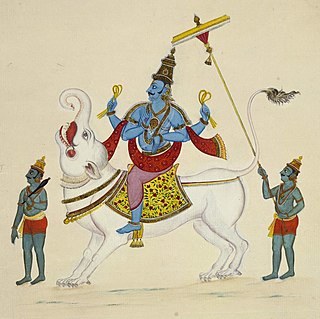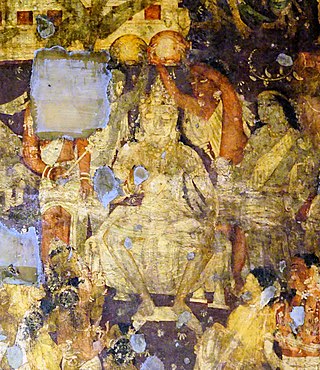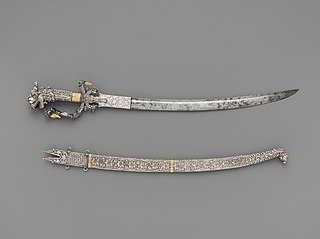
Varuna is a Hindu god, associated with the sky, oceans, and water. In the Vedic scriptures, he is paired with the god Mitra and is the lord of Ṛta (justice) and Satya (truth). Varuna is also mentioned as an Aditya, the sons of the goddess Aditi.

The flag of Sri Lanka, also called the Sinha Flag or Lion Flag, consists of a golden lion holding a kastane sword in its right fore-paw in a maroon background with four gold bo leaves, one in each corner. This is bordered by gold, and to its left are two vertical stripes of equal size in teal and orange, with the orange stripe closest to the lion. The lion and the maroon background represent the Sinhalese race, while the saffron border and four bo leaves represent the concepts of meththa, karuṇā, muditā and upecka respectively. The stripes represent the country's two largest minority ethnicities, with the orange representing the Tamils inhabitants—namely the Sri Lankan Tamils and the Indian Tamils of Sri Lanka—and the teal stripe representing the Sri Lankan Moors. The golden yellow border is a catch-all representing the various minority communities of the country.

The culture of Sri Lanka mixes modern elements with traditional aspects and is known for its regional diversity. Sri Lankan culture has long been influenced by the heritage of Theravada Buddhism passed on from India, and the religion's legacy is particularly strong in Sri Lanka's southern and central regions. South Indian cultural influences are especially pronounced in the northernmost reaches of the country. The history of colonial occupation has also left a mark on Sri Lanka's identity, with Portuguese, Dutch, and British elements having intermingled with various traditional facets of Sri Lankan culture. Additionally, Indonesian culture has also influenced certain aspects of Sri Lankan culture. Culturally, Sri Lanka possesses strong links to both India and Southeast Asia. For over 2,500 years, India and Sri Lanka have nurtured a legacy of historical, cultural, religious, spiritual, and linguistic connections.
The caste systems in Sri Lanka are social stratification systems found among the ethnic groups of the island since ancient times. The models are similar to those found in Continental India, but are less extensive and important for various reasons. Modern times Sri Lanka is often considered to be a casteless society in south asia.

Prince Vijaya was a legendary king of Tambapanni, based in modern day Sri Lanka. His reign was first mentioned in Mahāvaṃsa. He is said to have came to Sri Lanka with seven hundred followers after being banished from Sinhapura. However, there is no archaeological evidence of this.
Karaiyar is a Sri Lankan Tamil caste found mainly on the northern and eastern coastal areas of Sri Lanka, and globally among the Tamil diaspora.

Karava is a Sinhalese speaking ethnic group of Sri Lanka, whose ancestors migrated throughout history from the Coromandel coast, claiming lineage to the Kaurava royalty of the old Kingdom of Kuru in Northern India. The Tamil equivalent is Karaiyar. Both groups are also known as the Kurukula.

Makara is a legendary sea-creature in Hindu mythology. In Hindu astrology, Makara is equivalent to the Zodiac sign Capricorn.

Konda in medieval times signified a group of Karava nobles in Sri Lanka. Old timers referred to them as Konda Karáva another clan of the Karava similar to the Suriya clans Kurukulasuriya, Warnakulasuriya, Mihindukulasuriya, Bharathakulasuriya, Manukulasuriya, Arasakulasuriya and Kón Karávas. Konda came to mean hair in Sri Lanka only after the 15th century Kotte period. Prior to that hair was referred to in the Sinhala language as kes, varalasa, dhammilla or muhulasa.
The following is a chronological overview of the history of the Karavas and Karaiyars caste of Sri Lanka and India. Both communities were historically also known as Kurukulam, meaning Kuru clan.

The National Emblem of Sri Lanka is used by the State of Sri Lanka and the Sri Lankan government in connection with the administration and government of the country. The current emblem has been in use since 1972 and created under the ideas and guidance of Nissanka Wijeyeratne. At the time, he was Permanent Secretary to the Ministry of Cultural Affairs and Chairman of the National Emblem and Flag Design Committee. The designer of the emblem was Venerable Mapalagama Wipulasara Maha Thera, and the artwork was by S. M. Seneviratne.

The flag of the Jaffna kingdom of the Aryacakravarti line of kings of Jaffna kingdom in northern Sri Lanka consisted of the couchant bull, the silver crescent moon with a golden sun. The single sacred conch shell, which spiral open to the right, and in the centre above the sacred bull, is a white parasol with golden tassels and white pearls. The color of the Royal Flag is saffron. The flag symbols are similar to number of flags found in India especially belonging to the Eastern Ganga dynasty. The Setu coins minted by the Aryacakravarti kings also have a similar symbol.
Social class in Sri Lanka is often described as casteless, though caste is still found on the island in both a symbolic and a practical sense. Caste is also used in an analogous sense to refer to the new social class divisions that have appeared in recent decades. The combination of ethnic nationalist movements that saw caste as an island-wide dividing tool, strong emphasis on providing access to education and healthcare regardless of background, and historic lack of discrimination among the colonial civil service played a factor in eradicating the caste system in most sectors of the island's society. Although the Buddhist culture actively fought against all forms of class discrimination, many Buddhist organizations used caste as a method to extract surplus from temple property.
The Battle of Mulleriyawa in 1559 was part of the Sinhalese–Portuguese War. It was one of the most decisive battles in Sri Lankan history and considered as the worst defeat of Portuguese during that period. According to local chronicles the marshlands of Mulleriyawa turned red with blood after the annihilation of the Portuguese. With this victory Sitawaka emerged as a military power which was able to challenge the Portuguese expansion.

The Kingdom of Kotte, named after its capital, Kotte, was a Sinhalese kingdom that flourished in Sri Lanka during the 15th century.

Gal Oya National Park in Sri Lanka was established in 1954 and serves as the main catchment area for Senanayake Samudraya, the largest reservoir in Sri Lanka. Senanayake Samudraya was built under the Gal Oya development project by damming the Gal Oya at Inginiyagala in 1950. An important feature of the Gal Oya National Park is its elephant herd that can be seen throughout the year. Three important herbs of the Ayurveda medicine, triphala: Terminalia chebula, Terminalia bellirica and Emblica officinalis are amongst the notable flora of the forest. From 1954 to 1965 the park was administrated by the Gal Oya Development Board until the Department of Wildlife Conservation took over administration. The national park is situated 314 km from Colombo.

A kastane or kasthane is a short traditional ceremonial or decorative single-edged Sri Lankan sword. The sword is featured in the Flag of Sri Lanka.

The Sinhalese monarchy has its origins in the settlement of North Indian Indo-Aryan immigrants to the island of Sri Lanka. The Landing of Vijay as described in the traditional chronicles of the island, the Dipavamsa, Mahavamsa and Culavamsa, and later chronicles, recount the date of the establishment of the first Sinhala Kingdom in 543 BC when Prince Vijaya, an Indian Prince, and 700 of his followers are claimed to have landed on the island of Sri Lanka and established the Kingdom of Tambapanni. In Sinhalese mythology, Prince Vijaya and followers are told to be the progenitors of the Sinhalese people. However according to the story in the Divyavadana, the immigrants were probably not led by a scion of a royal house in India, as told in the romantic legend, but rather may have been groups of adventurous and pioneering merchants exploring new lands.

Korawakgala, or koravakgal (wingstones), are stone balustrades, which are located on either side of the stairs/steps leading to the entrance or door of a religious building or structure. They form one of three distinct architectural features at the entrance of most Buddhist structures in Sri Lanka, being the sandakada pahana (moonstone), muragala (guardstones) and the korawakgala (wingstones).


























